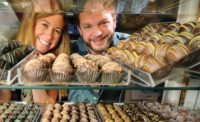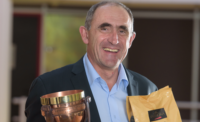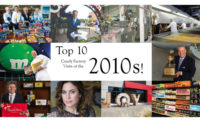Call of cacao: An inside look at a Brazilian cocao farm
Boyhood summer visits to his family’s idle cocoa plantations become a driving force for Diego Badaró. In resurrecting the Badaró fazenda, he’s also become a driving force for pioneering premium chocolate amongst Brazilians.

Diego Badaró welcomes visitors to his retail shop in Sao Paulo, which doubles as his urban test kitchen.







From the doorway that leads to his factory in Salvador to the cocoa plantation in Monte Algere in Bahia, from the reconditioned winnower to slow conching, every aspect of “tree-to-bar” production is done with the goal of producing fine Brazilian chocolate.








It was a traumatic moment for a 9-year-old boy, seeing his grandmother crying while she was talking to his mother. When Diego Badaró asked his mother what happened, she told him that his grandmother’s tears stemmed from neighbors cutting down cacao trees. A way of life was disappearing.
For Badaró, who as a little boy spent his summers on the family cocoa plantation, that moment in time became a life-changing experience. The appearance and proliferation of witches’ broom disease in Brazil in 1989 devastated the country’s cacao growing region of Bahia.
Although the Badaró family didn’t cut down any cacao trees, it did abandon them in 1990. There seemed no reason to continue in the wake of a disease that destroyed three-quarters of the country’s cacao trees.
As a fifth-generation Badaró, Diego felt drawn to his family heritage and legacy.
“I love nature,” he says. Thus, in 2001 he began the slow process of reinvigorating the plantation, pruning, clearing and planting as need be.
But it wasn’t just about resurrecting the cacao plantation; Badaró wanted to go one step further, from “tree-to-bar.”
“I met a lot of resistance,” he recalls. Young and persistent, Badaró attended a variety of workshops, read countless books on the subject and eventually got to the point he felt comfortable sending out his beans for evaluation.
His first hint of success came from France, when renowned chocolatier Francois Payard, used his cocoa beans to capture first prize in the Chocolate du Salon exhibit in Paris in 2005. Payard again used Badaró’s beans to capture 2nd place the following year.
Certainly, the tireless efforts of revitalizing the family’s cocoa plantation into a fine-flavored cocoa fazendo were beginning to literally bear fruit. The journey continued when he happened to purchase a Dagoba bar. Intrigued, he researched the company and subsequently sent then owner, founder and chocolate alchemist, Frederick Schilling, a sample of his beans.
Schilling, always on the prowl for new and flavorful cocoa beans, was immediately taken with the flavor and intensity of Badaró ’s beans. A collaboration began and the two met in January of 2007, setting the stage for the young cocoa farmer’s transition to a “tree-to-bar” chocolate maker. Schilling eventually became a partner, inspiring the cocoa farmer to become a chocolate maker.
Despite a variety of bureaucratic hurdles — it took two years before Badaró was able to begin producing chocolate — the 1,500-sq.-meter factory open in Salvador, Brazil in 2010.
Today, there are 30 employees working an 8-hour shift Monday through Friday, turning out about 50 tons of chocolate products annually. All cocoa beans, which come from Badaró’s 150-hectare Monte Alegre plantation in Mata Altântica, Bahia, are visually inspected before being approved for roasting.
The cocoa beans are roasted on a Illa Opus 4 roaster, which handles 45-kilo batches. Roasting times vary between 20 to 30 minutes, with temperatures also ranging between 115° and 125° C. After roasting, the beans head toward a winnower, where the nibs are separated from the shells.
The nibs then head toward the conching room, where they undergo anywhere from 20 to 40 hours of conching. The gradual conching process is designed to fully develop flavors as well as remove any bitter notes.
The chocolate is then pumped into a tempering unit before being directed to a depositor that’s used to fill the bar moulds. The moulds are then fed into a cooling tunnel. Once cooled, employees demould the bars and place them on plastic boards. The bars are then fed into a packaging machine, which wraps the bars in foil. Afterwards, the foiled wrapped bars are placed into a special secondary wrapper, which highlights the bar’s origins and tells the AMMA story, the name of Badaró’s chocolate company.
AMMA — which can mean mother, seed of creation, and love —represents Badaró’s effort to reconnect humanity with nature.
“It’s all about getting back to one’s roots,” he says. “Cacao is a really a most complete food. It grows in a rich environment [under a canopy forest]. Typically the average age of Amazonian cacao trees is 110 years, but I’ve seen a tree that’s 235 years old. And when we harvest the cacao beans, there’s less than four hours between the time we open the pods and the time we begin fermentation.”
And while yields per hectare remain small compared to other areas — 200/250 kilos per hectare versus 350 kilos or more per hectare — the quality of the bean is what makes the operation successful.
“We go beyond Fair Trade,” Badaró says. “Our beans sell twice, three times, five times the market price.”
As a result, his chocolates also fetch a premium price. Currently, the company produces and sells 21 different varieties of chocolate, including a cupuaçu, a cousin of cocoa that’s produces a creamy, almost fudge-like aromatic bar.
Badaró operates two retail shops, one in Salvador, the other in São Paulo. The São Paulo “store” doubles as his test kitchen, urban headquarters, and cocoa café. Domestic sales account for half of Amma’s revenues, exports the other half.
Amazingly, in Brazil, Amma’s leading seller is a 100 percent cocoa content bar — a testament to the quality of the beans and the bar.
“My goal is to continue to develop the Brazilian fine chocolate category, to educate and convert Brazilians to what premium chocolate is all about,” Badaró says.
Check out the rest of our Brazilian cocoa content:
Looking for a reprint of this article?
From high-res PDFs to custom plaques, order your copy today!














